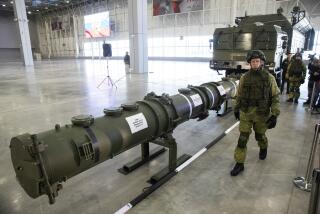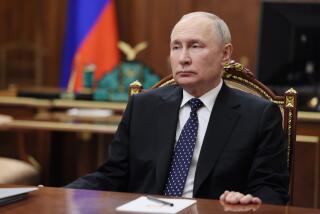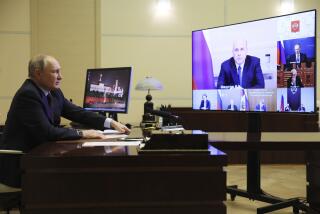THE REYKJAVIK SUMMIT : Test Ban Treaties Date From Period of U.S.-Soviet Detente
- Share via
REYKJAVIK, Iceland — The two nuclear testing treaties that President Reagan now intends to submit to the Senate for ratification stem from the period of Soviet-American detente but were never formally sent to Congress.
The treaties are being submitted now, it appears, partly because of growing pressure on Reagan to match the unilateral testing moratorium put in place by Soviet leader Mikhail S. Gorbachev more than a year ago and partly because new technology makes it possible to monitor underground nuclear tests with greater accuracy.
The first treaty, called the Threshold Test Ban Treaty, was signed by former President Richard M. Nixon in Moscow in 1974, but he soon resigned over the Watergate scandal. His successor, President Gerald R. Ford, signed the Peaceful Nuclear Explosions Treaty in 1976, but he was defeated by Jimmy Carter before he could send it to the Senate.
Both agreements restrict underground tests to a yield of 150 kilotons (equal to 150,000 tons of TNT) and forbid any release of radioactivity into the atmosphere except for small, inadvertent “venting” events.
In 1963, when the first test ban was signed, both superpowers promised to stop detonating nuclear weapons in the atmosphere. This limited test ban was subsequently extended to the oceans and to space.
President Carter decided to withhold both the Threshold Test Ban Treaty and the Peaceful Nuclear Explosion Treaty from Congress, although he endorsed them, because he sought to go them one better by negotiating a total or comprehensive ban on all underground blasts. But his efforts died with the Soviet invasion of Afghanistan in 1979.
Inadequate Monitoring
Reagan, for his part, decided when he took office in 1981 that the two agreements could not be adequately monitored to ensure against Soviet cheating.
Underground nuclear tests are very difficult to distinguish from natural earthquakes and other seismic events. Generally, a 150-kiloton test could register as anywhere between 75 kilotons and 300 kilotons to seismic monitors at any distance from the test site.
The Reagan Administration has accused the Soviets of probably violating the 150-kiloton limit on numerous occasions, a charge vigorously denied by Moscow. However, in the absence of better verification measures, the dispute has never been resolved.
Beyond the verification dispute, however, this Administration has opposed a test ban for other reasons, including the need to devise warheads for new ballistic and cruise missiles and to ensure the reliability and safety of the weapons that form the basis of the U.S. nuclear deterrent strategy. All of these goals required continued testing, in the Administration’s view.
But, under heavy pressure from Congress as well as domestic and international opinion, Reagan offered to submit the two treaties for ratification if the Soviets agreed to accept monitoring provisions that would better measure the power of each test.
The Soviets, repeatedly complaining about the White House’s refusal to carry through with signed agreements, replied by insisting that the treaties should be ratified first and verification issues taken up afterwards.
Administration Proposes
In this impasse, and amid the Soviet moratorium on all testing, the Administration proposed that the Kremlin send scientists to U.S. test sites to witness demonstration of the so-called CORTEXX system of directly measuring the yields of tests.
The system consists of a coaxial cable--one cable within a second cable--hung down a hole near or at the test site. An electric current passes down one cable and returns to the surface in the other. When an explosion occurs, the cable is crushed, reducing its length. The rate at which its length shortens is a measure of the explosion size, to within 15% of its true value, depending on its nearness to the blast.
The Soviets have so far refused to allow their scientists to visit U.S. sites to examine CORTEXX but last summer allowed some U.S. private scientists to set up instruments on their territory, in what seemed to be a first move toward proving the value of the instruments.
The CORTEXX system would still leave some uncertainties about the yield of nuclear tests, depending primarily on how close the instruments were to the explosion.
Within the Administration, some Pentagon officials want the CORTEXX cable in the same hole or tunnel as the explosion, a degree of intrusiveness that the Soviets are unlikely to accept even if they accepted the virtues of the system for policing underground tests.
More to Read
Sign up for Essential California
The most important California stories and recommendations in your inbox every morning.
You may occasionally receive promotional content from the Los Angeles Times.










